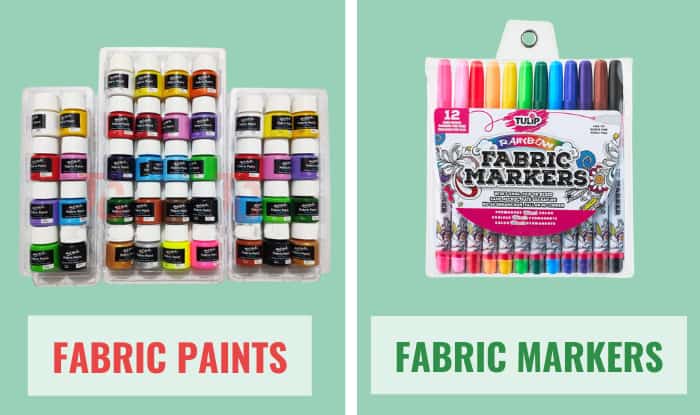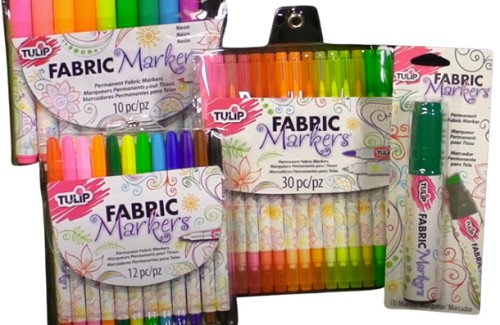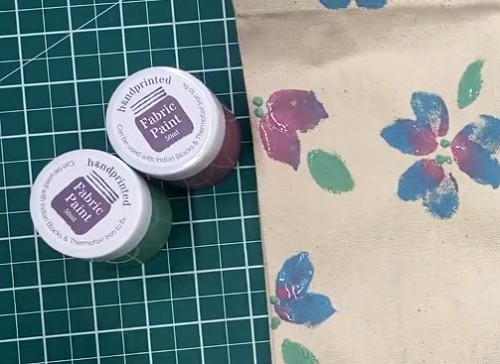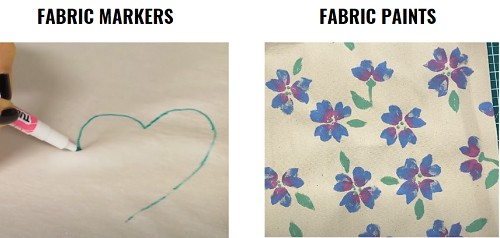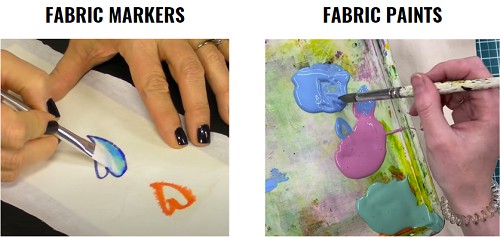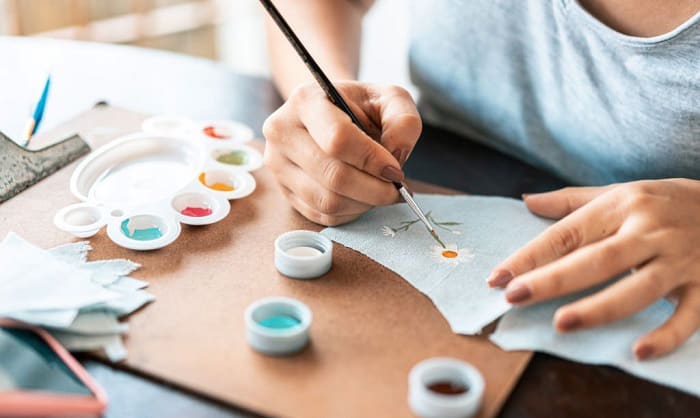Do you need a thorough understanding of the differences between fabric paints and markers? The truth is, these tools have the same goal: to color and decorate fabric. However, the significant differences fall under the application, drying time, blending capabilities, and handling or application method.
To distinguish and compare these two kinds of fabric tools, our review of fabric markers vs fabric paint will unravel their benefits and drawbacks, and offer recommendations on how to use them. In that way, you can choose the right one for your specific task.
Table of Contents
What is the Difference Between a Fabric Marker and a Fabric Paint?
1. Fabric Markers
What are fabric markers? Similar to regular markers, fabric markers are made specifically to work on fabric or cloth using a pen-type application.
They come in a wide range of colors and tip sizes, and can be used to make artful patterns and designs. These are also known as “fabric paint pens.”
The fabric marker’s precision and control are two of its main advantages. These paint pens work on fabric, especially for fine lines and small details, producing intricate and precise designs.
Additionally, they are a fantastic choice when working with small or delicate fabrics. For that reason, many artists consider these their preferred markers to draw on clothes.
2. Fabric Paints
In contrast, fabric paint is a thicker, more opaque medium that can be used to create eye-catching, vibrant designs.
It is offered in a variety of surface compatibility options, including glossy, matte, and metallic finishes. You can use them not only on t-shirts but also on bigger canvases or tarpaulin-sized fabrics.
Two of the most admired qualities of fabric paint are its longevity and toughness. Fabric paint, which can be applied with a paint brush, sponge, or stencil, can also be used to create large or striking designs.
Heat-setting fabric paint improves the color and its resistance to washing and fading, making fabric markers permanent and durable.
A Quick Overview
| FEATURES | Fabric Markers | Fabric Paint |
| Application | Fine lines and intricate patterns on a single design | Larger designs and bigger patterns |
| Drying Time | Fast-drying and permanent | Slow drying time and permanent |
| Handling or Application method | Simple to use like a typical drawing pen | Needs painting tools like a brush, sponge, or stencil |
| Blending Capabilities | Does not blend well due to the quick-drying feature | Blending can be done by mixing colors before their use |
| Durability/Longevity | Tough and mostly last long | Very durable and last longer |
| Skill Level | Ideal for beginners and amateurs. Professionals use them for fine lines | Ideal for professional and experienced painting artists |
| Price | Typically expensive | More affordable in volume |
For a thorough comparison of fabric markers vs. fabric paint, let’s go over a few criteria in more detail.
Breakdown of Features
01 ApplicationUse paint markers on fabric whenever you plan to make fine lines and intricate patterns because they apply with a pen-like tip. You may also use fabric markers on t-shirts if a few original designs are needed.
On the other hand, fabric paint is more useful for achieving a wide variety of designs, textures, and effects using a brush, stencil, or sponge. Fabric paint is more suitable for larger designs and bigger fabric sizes.
02 Drying TimeFabric markers typically dry faster. Fabric paints are thicker and take longer to dry, but are generally more durable.
03 Blending and Mixing CapabilitiesSince these are pen-like instruments, fabric markers are more practical and simpler to use. No wonder many artists use these tools as their fabric markers for t-shirts and many other small or delicate fabric types.
However, blending with other colors is quite challenging due to its quick-drying formulation. Fabric paints, on the other hand, have higher mixing and blending capabilities, but these should be done before using them or while they are still wet.
04 Durability and LongevityFabric paint is more resilient than fabric markers. The cracking, peeling, and fading resistance of fabric paint is higher. Though fabric markers are also permanent and durable, they are not as durable as fabric paints.
05 Skill LevelNo special skills are needed to use fabric markers unless you plan on making complicated designs. They are similar to regular pens, and an amateur or a newbie can use them freely.
On the other hand, fabric paint needs painting tools that require mastery and extra skill to be able to use them more effectively.
06 PriceFabric markers are cheaper than fabric paint. For as low as $5, you can already have a set of fabric markers. However, in terms of the scope of painting fabric or surfaces, more pen markers are needed to match what fabric paints can cover.
Therefore, you can save more money with fabric paints in the long run. They can cover large surfaces without consuming too much paint. Thus, fabric paints are cheaper compared to fabric markers by volume.
Pros & Cons of Fabric Markers and Fabric Paints
1. Fabric Markers
| PROS | CONS |
| user-friendly and simple to use | does not blend well |
| with permanent ink | more expensive in making wider coverage |
| ideal or fine lines & delicate designs | not easy to use on bigger designs |
| fast-drying | |
| readily available in most shops and bookstores |
2. Fabric Paint
| PROS | CONS |
| mixes well with other colors due to slow drying time | needs painting tools like a brush or sponge |
| very durable and lasts long even when washed | not quick-drying |
| Ideal for bigger designs and patterns | needs expertise in the handling and use of painting instruments. |
| Very practical for a larger coverage and art projects |
Frequently Asked Questions
Is fabric paint or fabric markers better?
In some areas, we can say that one is better than the other. For instance, fabric markers are handy and can be used like regular marker pens. Such design allows the user to create complex details with better control.
Meanwhile, fabric paint requires an applicator such as a paint brush or sponge. Although it may not be as handy as markers, it is a better choice for large-scale projects.
Are fabric paint markers permanent?
Yes. Fabric markers contain permanent colors that do not fade or wear out quickly over time.
What is the difference between permanent markers and fabric markers?
Although both tools are permanent, fabric markers are specifically designed to be used on fabric. Permanent markers may also be used on fabric but the results may vary since they are intended for other surface types.
Aside from that, fabric markers offer more color options.
Can you use fabric markers on any kind of fabric?
Most types of fabrics, including cotton, canvas, polyester, and nylon, can be designed with fabric markers.
But to achieve the best results, it is always a good idea to test the fabric marker on a small patch of fabric first to check any changes. This way, you can prevent the markers from bleeding, fading, or any damage to the fabric.
Can you use fabric paint on any kind of fabric?
Not all fabrics can be used with fabric paint, just like with fabric markers. Some fabrics might not absorb paint well or might stiffen up after being painted.
It is highly recommended to always perform an initial painting first on a similar fabric or a discrete portion of one.
With that in mind, fabric paint works great on fabrics derived from linen, wool, silk, and cotton. Apart from that, synthetic fabrics are not the best options for fabric paint. Consider natural fabrics because the paint adheres well to their natural fibers.
Can you wash fabric paint?
Yes, fabric paint can be washed, but make sure to follow the manufacturer’s washing and maintenance instructions. It is crucial to select a fabric paint that is appropriate for the fabric you are working with because some types of fabric paint might be more durable than others.
Besides that, the correct washing process helps preserve the quality of paint.
Useful Tips and Suggestions
- Before beginning your project, test fabric markers and fabric paint on an inconspicuous area of the fabric to make sure the ink or paint does not bleed or fade.
- To stop bleeding or smudging, place a piece of cardboard or a fabric stabilizer inside the fabric.
- Some paint pens wash off fabric surfaces when not properly cared for. When using fabric paint and markers, make sure to follow the manufacturer’s washing and maintenance instructions to preserve the quality of paint.
- After using fabric paint or permanent fabric markers, seal the design with a fabric sealant to prolong its life.
- Always allow the paint to dry completely before you wash the fabric or heat set the paint.
Conclusion
Fabric paint and fabric markers are both excellent choices for embellishing fabrics. However, each has particular advantages and disadvantages. The decision between the fabric markers vs fabric paint will be based on the nature of your project and the desired result.
Markers are practical and simple to use, but they might not last as long as fabric paint. Although it can produce more complex shapes and designs and is more versatile, fabric paint can also be more challenging to use, messier, and take longer to dry.
Before using the paint or markers on a larger area of fabric, test them on a small patch first and make sure you are following the manufacturer’s instructions.

Art has always been a part of my life; it influences my upbringing and later my career choice. For me, it is always a part of my parenting technique. So for whichever purpose that you come to art, you can start here with us.
